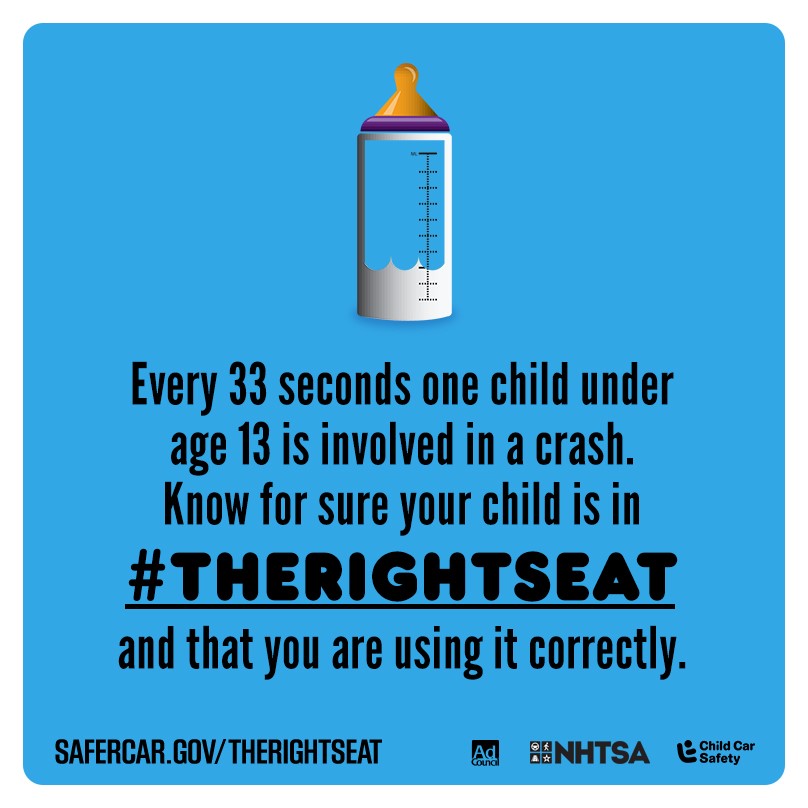 Did you know that every 33 seconds a child under 13 is involved in a car crash in the United States? That can be a pretty scary thought—and will probably (hopefully) get you thinking about making sure your child is safely snuggled into a car seat every time you head out to school, the grocery store, or anywhere else around town. But how do you know if your child is in the right seat?
Did you know that every 33 seconds a child under 13 is involved in a car crash in the United States? That can be a pretty scary thought—and will probably (hopefully) get you thinking about making sure your child is safely snuggled into a car seat every time you head out to school, the grocery store, or anywhere else around town. But how do you know if your child is in the right seat?
 One of the goals of Child Passenger Safety Week is to help parents and caregivers answer that exact question. It starts with a visit to SaferCar.gov/TheRightSeat (or SaferCar.gov/Protegidos for Spanish) where you’ll learn how to tell whether a child is in the right seat for his or her age and size, and to locate a car seat check station in your area. But wait, there’s more: we also want to encourage you to register your child’s car seat with the manufacturer so they can let you know if there’s ever a recall.
One of the goals of Child Passenger Safety Week is to help parents and caregivers answer that exact question. It starts with a visit to SaferCar.gov/TheRightSeat (or SaferCar.gov/Protegidos for Spanish) where you’ll learn how to tell whether a child is in the right seat for his or her age and size, and to locate a car seat check station in your area. But wait, there’s more: we also want to encourage you to register your child’s car seat with the manufacturer so they can let you know if there’s ever a recall.
Is Your Child In The Right Seat?
- Your child under 12 months should always ride in a rear-facing car seat.
- Children ages 1-3 should be kept rear-facing as long as possible.
- Keep your child in the back seat at least through age 12.
- Be certain you’ve installed your car seat correctly by having it checked at an inspection station or by a certified child passenger safety technician. Bring the Car Seat Instructions and the Vehicle Owner’s Manual with you to your seat check appointment!
Is Your Seat Installed Properly?
 Installation Resources: If a car seat isn’t installed correctly, your child’s safety could be in danger. Every car seat has different installation instructions. You can find resources and tips here to help you find the right one: https://www.safercar.gov/parents/RightFit.htm
Installation Resources: If a car seat isn’t installed correctly, your child’s safety could be in danger. Every car seat has different installation instructions. You can find resources and tips here to help you find the right one: https://www.safercar.gov/parents/RightFit.htm
Free Car Seat Checks: During Child Passenger Safety Week, there will be more than 600 events in 45 states across the country, where certified child passenger safety technicians will inspect car seats and show parents and caregivers how to correctly install and use them. In most cases, this service is free of charge. Locate a car seat check event here: https://www.safercar.gov/cpsApp/cps/index.htm
Car Seat Safety Tips:

- Find a car seat that fits your child. As children grow, how he or she sits in your car will change. Make sure the car seat you purchase is designed to fit your child’s current size and age.
- Not all car seats fit in all vehicles, so test the one you plan to buy to make sure it fits well in your vehicle.
- Before putting your child in a car seat, read the manufacturer’s instructions so you know how the seat works.
- All-in-One car seats have the advantage of using the same seat for three stages: rear-facing, forward-facing with harness, and booster. These seats typically have higher height and weight limits for the rear-facing position, allowing you to keep your child rear-facing for a longer period of time.
Remember, the best car seat is the one that fits your child properly, is easy to use, and fits in your vehicle correctly.
Get this message out to your friends and family!
- Twitter: Many parents don’t realize it if their child is in the wrong car seat. Visit gov/TheRightSeat to make sure your child is riding safely. #therightseat.
- Facebook: Storks know how to keep kids safe. Do you? Visit safercar.gov/therightseat to know for sure that your child is in the right seat for their age and size. #STORKS #TheRightSeat




